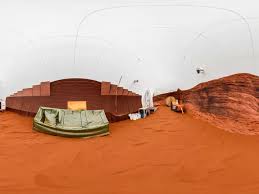NASA’s CHAPEA Project:

After a year-long simulated Mars mission as part of the CHAPEA project, a NASA crew emerged from their 17,000 sq ft habitat at Johnson Space Centre.
- Crew Health and Performance Exploration Analog (CHAPEA) is a series of analog missions conducted by NASA that will simulate year-long stays on the surface of Mars.
- It aims to assess and collect data regarding NASA’s food system and physical and behavioral health patterns in humans, which will help during future space missions.
- Each mission will consist of four crew members living in Mars Dune Alpha, an isolated 1,700-square-foot habitat.
- Mars Dune Alpha is a 3D-printed structure located at Johnson Space Center in Houston, Texas.
- It simulates a realistic Mars habitat to support long-duration, exploration-class space missions.
- The analog mission will be as Mars-realistic as feasible, which may include environmental stressors such as resource limitations, isolation, equipment failure and significant workloads.
- During the mission, the crew will conduct simulated spacewalks and provide data on a variety of factors, which may include physical and behavioral health and performance.
- After the successful completion of this mission recently, two more are scheduled for 2025 and 2026.




